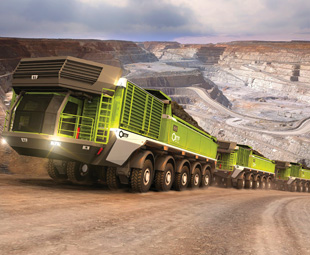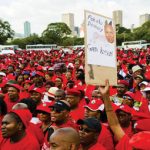Ground control to mining haulier

Frank Herbert famously states in his sci-fi epic, Dune: “He who controls the spice, controls the universe.” Today, engineers and designers are encouraged to create more space-age like vehicles to fulfill requirements across all sectors of industry. FOCUS investigates some brave new ideas.
As things stand today, it seems that the chances of owning any of the flying cars or hover-boards of the Back to the Future series are slim at best. As disappointing as this may be, the future of mining vehicles nevertheless remains far from mundane.
Haulage to and from open mines accounts for a great proportion of mining costs, which creates the rising need for more cost-effective mining trucks and hauling equipment. This continually pushes engineers and designers to create more effective vehicles to keep these primary industries rolling along smoothly – the results sometimes appearing more akin to science fiction than current fact.
As more stringent emission regulations become the order of the day, the need for more emission-friendly mining vehicles has become an important conversation in all industries that rely on internal combustion.
Electric drive systems for mining vehicles are nothing new as General Electric (GE) introduced its first hybrid drive systems for mining trucks five years ago. The hybrid truck was designed together with the United States’ Department of Energy (US DOE) and has proved to be 10 percent more fuel efficient than its diesel counterparts. In turn, the US DOE found that this improved overall mining productivity by five percent.
Of course, the idea of hybrid hauling vehicles carrying tonnes of coal is an ironic one indeed. However, the US DOE statistics claim that while large heavy commercial vehicles make up only about four percent of vehicles on US roads, they are responsible for a staggering 20 percent of the country’s on-road fuel consumption. Therefore it makes sense to reduce the emissions of these vehicles.
 Alongside GE’s initiative to hybridise its mining vehicles, other companies such as Volvo and the European Truck Factory (ETF) have begun to look even further into the future, with some interesting results.
Alongside GE’s initiative to hybridise its mining vehicles, other companies such as Volvo and the European Truck Factory (ETF) have begun to look even further into the future, with some interesting results.
Instead of relying on solid drive axles, the theoretical ETF mine hauling trucks have been designed with a revolutionary new system of independent wheel assemblies.
With each wheel capable of steering itself, and powered by its own motor, traction for the ETF truck is considerably better than that of current models worldwide. This, “all-wheel-drive, all-wheel-steering” also significantly improves the shock absorption of the vehicle as each independent wheel now only accounts for itself, oscillating with its terrain.
As each wheel is capable of turning independently, the rate of turn is significantly faster and sharper than that of other hauling trucks.
However, perhaps the most innovative idea from ETF is the “Haul Train” link-up system its trucks will be able to employ.
In short, ETF trucks will be able to link together to form an automated land train. With half a dozen or more of these vehicles linked to each other, only a single driver will be required to operate the front vehicle, as all the trucks linked to the first one mimic its movement. This implies that not only are fewer drivers needed to operate haulage trucks, but a large amount of time is also spared in coordinating the movements of a fleet.
A recent system similar to that of the ETF haul truck is being developed for commercial road use by the European Commission. Known as the Safe Road Trains for the Environment (SARTRE) project, it has already undergone a set of successful tests with light road vehicles linked to, and travelling in the aerodynamic slipstream of, a truck.
Aimed primarily at lowering fuel consumption and road accidents in light-weight personal transport, the SARTRE system was also recently successfully tested in the United Kingdom and Europe. A road train of Volvo trucks was linked together wirelessly and piloted only by the driver of the first truck.
The SARTRE project may be institutionalised in Europe sooner rather than later, but the safety and coordination concerns that come with mining logistics will probably require a great deal more testing. ETF, however, remains confident of its ability to manufacture these vehicles in the near future. A working prototype has, however, yet to be built.
With a similar idea regarding suspension, Volvo’s theoretical haulier, the Centaur, also has some impressive new tricks up its sleeve.
Designed as a conceptual starting point for mining vehicles for the 2020s, the Centaur’s operator cockpit has been designed to lower itself to the ground, eliminating such current necessities as climbing rails. This in turn makes the cockpit design much smaller while providing a larger field of view for the driver.
Furthermore, the bubble-shaped cockpit will feature an advance head-up display (HUD) on its windscreens that will greatly increase driver awareness. Laser-operated terrain sensors detect any people or obstacles that need to be avoided.
The Centaur’s tipper is also designed to contract itself while tipping its cargo. This improves the speed at which loads are dumped, and also helps to keep a low centre of gravity while doing so, promoting better stability.
Perhaps the most innovative idea to come from Volvo’s Centaur, is its ability to detach its driver’s cab from the rest of the vehicle. Using a complex gyroscopic system similar to that found on Segway transporters, the Centaur’s cab will be able to drive around on its front two wheels, making it a vehicle that can quickly interchange functions and thus a lot more versatile than regular hauliers.
 Perhaps the concept most akin to a TV-series like Space 1999 would be the Super Tipper Truck created by Asian design guru, Haishan Deng.
Perhaps the concept most akin to a TV-series like Space 1999 would be the Super Tipper Truck created by Asian design guru, Haishan Deng.
Deng, who is director of transportation design at the Guangzhou Academy of Fine Arts, was asked by Dutch company Meiller Kipper to create a futuristic concept for the next century.
Capable of dumping its load from all sides, the Super Tipper may greatly reduce the time and space needed for dumping. With a spidery set of independent wheels, the Super Tipper can hypothetically also cross terrain that would be impossible for contemporary hauliers. Although the Centaur and the ETF Haulier will most likely operate on hybridised motors, the Super Tipper will undoubtedly run on an electric motor, as there is little in the way of space for a large, bulky internal combustion engine to propel it forward.
Besides the Super Tipper, Deng is also known for having designed a regular commercial road truck, known as the Chameleon. Like the Super Tipper, the Chameleon also allows for unilateral unpacking of its haulage from size-adjustable trailers and mobile cockpits.
There is an engineering saying: with more moving parts come more things that can break down. Electric motors operate purely on electromagnetic induction, without the moving parts found in petrol and diesel engines. Until recently, only large trains, capable of drawing electricity from the power lines above or below them, could rely on electric motors.
However, the advantages of electrical drive systems for vehicles has become clear and the technology behind lithium batteries is advancing at a pace similar to that of digital cameras 15 years ago. As the speed at which batteries can be charged and keep their charge increases, an electrical paradigm-shift seems very possible within the next generation.
Each of these innovations will bring a new set of maintenance and upkeep challenges, which may initially hinder the development of these new concepts. The single-wheel axis of both the ETF Haulier trucks and the Centaur will require a great deal of time and effort to be spent by mechanics if they break down. While hybrid engines certainly are more fuel efficient, they also hold their own maintenance challenges. However, both Meiller-Kipper and Volvo acknowledge that these concepts are currently exercises of the mind more than anything else.
History, however, has taught us that when mankind realises new technology is within its grasp, it takes little time indeed to assimilate it into its collective – perhaps giving us sufficient reason to look forward to some flying DeLoreans after all.
Published by
Focus on Transport
focusmagsa




